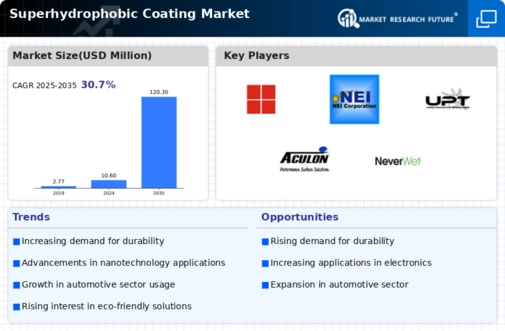Market Share
Superhydrophobic Coating Market Share Analysis
Market share positioning strategies in the Superhydrophobic Coating Market involve various tactics that companies use to gain a competitive edge and establish their presence in the industry. Superhydrophobic coatings, renowned for their water-repelling properties, have witnessed a surge in demand across diverse sectors such as automotive, electronics, construction, and textiles. To carve a niche and enhance market share, companies employ multiple strategies.
Firstly, differentiation through product innovation stands as a crucial approach. Companies invest heavily in research and development to create advanced formulations that offer enhanced durability, improved application techniques, and eco-friendly compositions. These innovations not only attract customers seeking superior performance but also establish brand loyalty, driving market share growth.
Furthermore, strategic partnerships and collaborations play a pivotal role. Collaborations between superhydrophobic coating manufacturers and industries like automotive or electronics foster mutual growth. By tailoring coatings to suit specific industry needs, companies can capture a significant portion of the market share. Such partnerships often lead to joint product development, expanding the application scope and widening market reach.
Effective marketing and branding strategies also contribute significantly to market share positioning. Companies utilize targeted marketing campaigns to highlight the unique features and benefits of their coatings. Through informative content, demonstrations, and endorsements, they aim to educate consumers and industries about the advantages of superhydrophobic coatings, thus increasing market penetration.
Moreover, pricing strategies impact market share positioning. Some companies adopt competitive pricing to capture a larger market share by offering their products at more affordable rates compared to competitors. Others focus on premium pricing by highlighting the superior quality and advanced technology of their coatings, targeting niche segments willing to pay a premium for top-notch products.
Geographical expansion is another crucial aspect of market share positioning. Companies strategically expand their presence into new regions and markets, leveraging global opportunities. Understanding regional demands, regulations, and preferences enables them to tailor their products accordingly, capturing market share in diverse geographical areas.
Customer-centric approaches are also pivotal in gaining market share. Providing exceptional customer service, offering customized solutions, and addressing specific pain points of consumers contribute to brand loyalty and retention. Satisfied customers often become advocates, helping companies expand their market share through positive word-of-mouth.
Lastly, continuous improvement and adaptation to technological advancements are essential for sustained market share growth. Companies that remain agile, embracing emerging technologies and trends, stay ahead in the competitive landscape. Regularly upgrading formulations, application methods, and sustainability initiatives help maintain a strong market position.








Leave a Comment